In recent years, data has become the backbone of advertising strategies, transforming the industry in numerous ways. It has become indispensable in advertising, driving innovation, efficiency, and effectiveness across the industry. As technology continues to evolve and data capabilities expand, advertisers will increasingly rely on data-driven insights to inform their strategies and achieve their marketing objectives.
In recent years, data has become the backbone of advertising strategies, transforming the industry in numerous ways. It has become indispensable in advertising, driving innovation, efficiency, and effectiveness across the industry. As technology continues to evolve and data capabilities expand, advertisers will increasingly rely on data-driven insights to inform their strategies and achieve their marketing objectives.
What is a DMP?
A Data Management Platform (DMP) in digital advertising is a centralized technology platform that aggregates and manages large volumes of data from various sources.
How Does a DMP Work?
As mentioned above, the primary purpose of a DMP is to collect, organize, and analyze data to create valuable audience segments for targeted advertising campaigns.
DMPs gather data across multiple sources. The collection consists of:
First-Party Data includes information collected directly from a company’s digital properties, such as websites, mobile apps, and customer relationship management (CRM) systems.
Second-Party Data refers to data shared directly between companies through partnerships or collaborations. For example, a publisher might share its audience data with an advertiser.
Third-Party Data that is acquired from external sources, such as data brokers, publishers, and other third-party providers.
DMP vs DSP: Understanding the Difference
Data Management Platforms (DMPs) and Demand-Side Platforms (DSPs) are vital components of the digital advertising ecosystem, each serving distinct functions.
DMPs specialize in collecting, organizing, and analyzing data from diverse sources to create audience segments for targeted advertising campaigns.
In contrast, DSPs primarily focus on ad buying and campaign management across various ad exchanges, networks, and publishers. They facilitate and simplify ad campaign creation, optimization, and performance tracking, allowing advertisers to bid on ad inventory in real-time auctions to reach their target audiences.
Nevertheless, both offer several advantages in the industry.
DMP benefits:
1) Creation of highly granular audience segments based on demographics, interests, behaviors, and intent signals.
2) Provision of value insights into audience preferences and behaviors, allowing advertisers to deliver personalized ad experiences tailored to individual interests and needs.
3) Optimization of targeting strategies by analyzing data trends and audience insights, leading to higher engagement and conversion rates.
DSP benefits:
1) Facilitation the delivery of personalized ads to specific audience segments, driving engagement and conversions.
2) Optimization of ad spend by dynamically adjusting bidding strategies and targeting parameters in real-time auctions.
3) Leveraging data from DMPs and other sources to make informed bidding decisions and optimize ad placements, resulting in more effective campaigns.
The Role of DMP in Advertising
The purpose of DMPs in digital advertising nowadays is crucial as they collaborate with a wide range of stakeholders to enable more effective and targeted digital advertising campaigns while ensuring compliance with data privacy regulations and industry standards. Advertisers are the primary users of DMPs. They leverage DMPs to collect and analyze data about their target audiences, create audience segments, and activate these segments for targeted advertising campaigns.
Frequently, DMPs may work with publishers to collect first-party audience data and optimize ad targeting on their platforms. In addition, DMPs collaborate with other ad tech platforms, such as Demand-Side Platforms (DSPs), Supply-Side Platforms (SSPs), and Ad Exchanges, to facilitate the buying and selling of digital advertising inventory. DMPs provide audience data that informs ad targeting decisions on these platforms.
Conclusion
In summary, the significance of Data Management Platforms (DMPs) in digital advertising lies in their ability to harness the power of data to enhance targeting precision, personalize ad experiences, optimize campaign performance, and drive better results for advertisers. Here’s why DMPs are essential in the digital advertising landscape, where data is the key to unlocking advertising success. By exploring the capabilities of Data Management Platforms (DMPs), businesses can transform their advertising efforts and drive remarkable results.
Don’t let your advertising efforts fall short. Explore the potential of DMPs today and review new possibilities for your business. It’s time to revolutionize your advertising strategies and achieve desired success in the digital realm!

